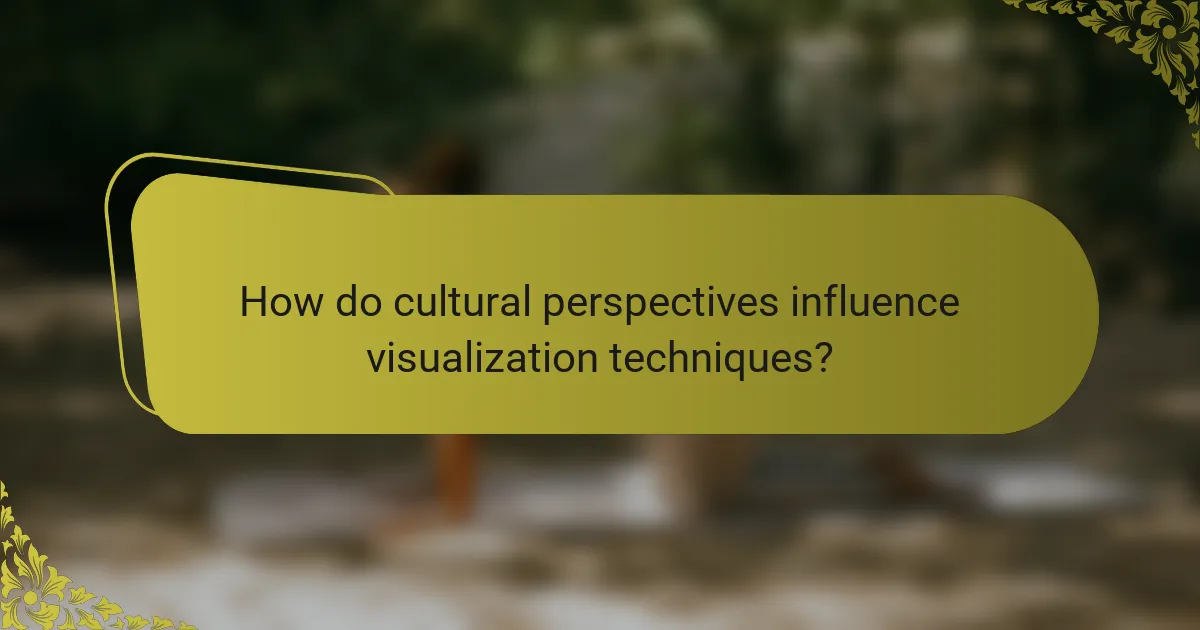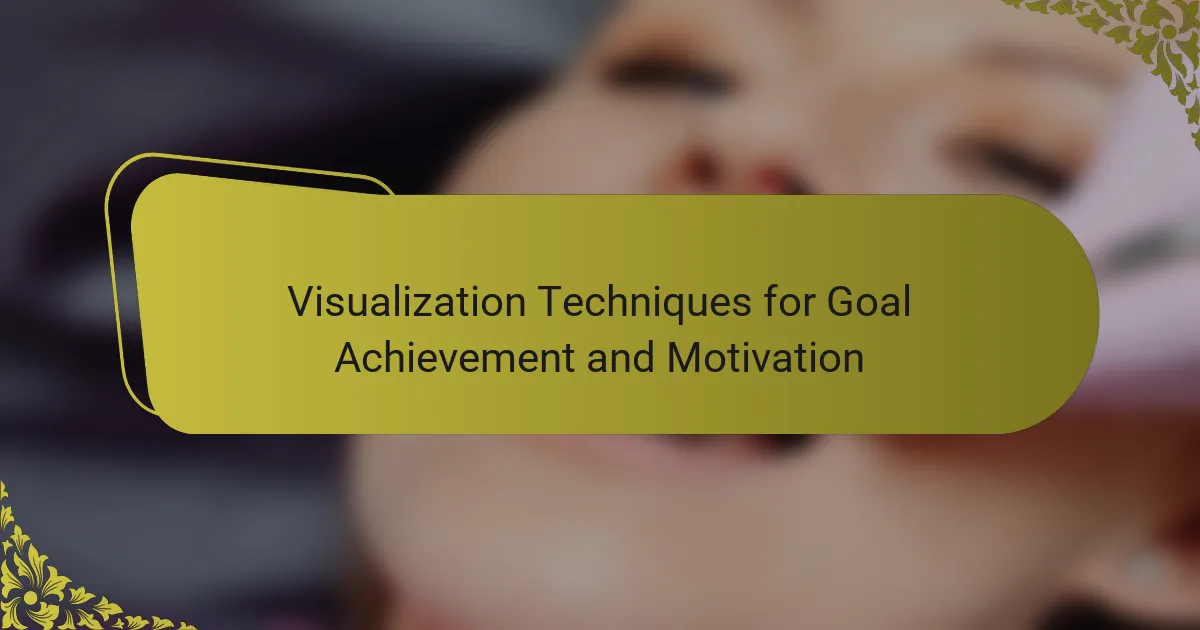Visualization techniques enhance goal achievement and motivation by fostering clarity and focus. This article explores the impact of mental imagery on performance, the importance of audience engagement, and the role of cultural factors in visualization. It also addresses challenges in implementation and highlights the latest trends in interactive and personalized visual tools.

How do visualization techniques enhance goal achievement and motivation?
Visualization techniques significantly enhance goal achievement and motivation by creating a mental image of success. These techniques foster clarity, focus, and emotional connection to goals, making them more attainable.
For example, studies show that athletes who visualize their performance improve their outcomes. Visualization also activates the brain’s neural pathways, reinforcing the belief in achieving goals. This mental rehearsal builds confidence and reduces anxiety, which are crucial for motivation.
Furthermore, consistent practice of visualization can lead to a unique attribute of resilience, helping individuals overcome obstacles. As a result, integrating visualization techniques into daily routines can lead to remarkable improvements in goal-oriented behaviours.
What psychological principles underpin effective visualization?
Effective visualization relies on psychological principles such as mental imagery, cognitive rehearsal, and the law of attraction. Mental imagery enhances motivation by creating vivid mental representations of goals. Cognitive rehearsal allows individuals to mentally practice achieving their goals, reinforcing confidence and focus. The law of attraction suggests that positive visualization can attract desired outcomes by aligning thoughts and actions with goals. These principles collectively boost motivation and facilitate goal achievement.
Which visualization methods are most commonly used for goal setting?
Visualization techniques for goal achievement and motivation include vision boards, mind mapping, and guided imagery. These methods enhance clarity and focus on objectives. Vision boards allow individuals to create a visual representation of their goals, while mind mapping organizes thoughts and ideas. Guided imagery involves mental visualization of success, reinforcing motivation and commitment. Each technique provides unique attributes that can significantly impact goal-setting effectiveness.
How does visualization impact performance and outcomes?
Visualization significantly enhances performance and outcomes by improving focus and motivation. Techniques such as mental imagery and guided visualization help individuals clarify goals and boost confidence. Research shows that athletes using visualization techniques can experience improved performance metrics, demonstrating the effectiveness of mental practice in achieving desired outcomes. Additionally, visualization fosters a positive mindset, which further motivates individuals to pursue their goals.

What are the key components of successful visualization practices?
Successful visualization practices involve clarity, relevance, and engagement. Key components include defining clear goals, selecting appropriate visualization types, and ensuring audience understanding.
1. Clear Goals: Establish specific objectives for the visualization to guide design choices.
2. Appropriate Types: Choose visualization formats (charts, graphs, infographics) that best represent the data and message.
3. Audience Engagement: Tailor visuals to the audience’s knowledge level and interests to enhance comprehension and motivation.
4. Feedback Mechanism: Incorporate ways to gather audience feedback for continuous improvement and adaptation.
How to create a compelling mental image for your goals?
Visualization techniques help create compelling mental images for your goals by enhancing motivation and focus. Start by defining your goals clearly. Use vivid imagery to represent these goals, engaging all your senses. Regularly practice visualization, ideally in a quiet space, for at least five minutes daily. Incorporate positive affirmations to reinforce your vision and foster belief in your ability to achieve it. As a result, this practice can significantly improve your goal achievement and overall motivation.
What role does emotional engagement play in visualization?
Emotional engagement significantly enhances the effectiveness of visualization techniques for goal achievement and motivation. Engaging emotions creates a stronger connection to the desired outcomes, making the visualization process more impactful.
When individuals visualize their goals with emotional intensity, they activate neural pathways associated with motivation and success. This connection increases commitment and persistence in pursuing those goals. Research indicates that emotionally charged visualizations can result in higher performance levels compared to neutral visualizations.
By incorporating emotions into visualization practices, individuals can foster a deeper sense of purpose and clarity, ultimately leading to greater motivation and achievement.
Which tools and resources can facilitate visualization techniques?
Visualization techniques can be enhanced with various tools and resources. Software like MindMeister and Trello helps organize thoughts visually. Apps such as Canva and Piktochart facilitate infographic creation. Additionally, resources like guided visualization exercises and motivational podcasts provide inspiration and context for goal achievement.

How can visualization techniques be tailored for different audiences?
Visualization techniques can be tailored for different audiences by considering their specific needs, preferences, and comprehension levels. For instance, children may benefit from colourful, cartoon-like visuals, while professionals might prefer data-driven graphics like charts and graphs.
Understanding the audience’s context is crucial. For example, athletes may respond well to motivational imagery that highlights success, whereas students might need diagrams that simplify complex concepts.
Utilizing interactive elements can also enhance engagement. Audiences such as corporate teams might appreciate tools that allow them to manipulate data, while general public presentations could focus on static visuals that convey messages quickly.
Lastly, cultural factors play a role in visualization. Tailoring content to align with cultural norms can improve relatability and effectiveness, ensuring that the visuals resonate with the audience’s values and experiences.
What approaches work best for athletes using visualization?
Visualization techniques that enhance goal achievement and motivation for athletes include mental imagery, guided visualization, and visualization rehearsal. Mental imagery allows athletes to create vivid mental pictures of their desired outcomes, boosting confidence and focus. Guided visualization involves listening to a coach or audio guide, helping athletes relax and visualize success. Visualization rehearsal enables athletes to mentally practice their skills, enhancing performance and reducing anxiety. Each technique can be tailored to individual preferences and specific goals, making them effective tools for motivation and achievement.
How do business professionals leverage visualization for success?
Business professionals leverage visualization techniques to clarify goals, enhance motivation, and track progress. These techniques include mind mapping, flowcharts, and vision boards, which help individuals visualize outcomes and maintain focus. For example, mind mapping organizes thoughts and strategies, while vision boards create a tangible representation of aspirations. Utilizing these methods can significantly improve goal achievement by reinforcing commitment and providing a clear roadmap.
Which strategies are effective for students in academic settings?
Visualization techniques enhance goal achievement and motivation for students. Effective strategies include mind mapping, vision boards, and progress tracking.
Mind mapping allows students to organize thoughts visually, improving comprehension. Vision boards inspire motivation by displaying goals and aspirations. Progress tracking provides a visual representation of achievements, reinforcing a sense of accomplishment.
These techniques cater to diverse learning styles, fostering engagement and retention. By incorporating visualization, students can clarify objectives and stay focused on their academic journey.

What challenges can arise when implementing visualization techniques?
Challenges in implementing visualization techniques include data complexity, user engagement, and resource constraints. Effective visualization requires clear objectives and alignment with user needs. Misinterpretation of visual data can lead to confusion and misinformed decisions. Additionally, technical limitations may hinder the creation of interactive or dynamic visualizations, impacting motivation and goal achievement.
How to overcome common barriers to effective visualization?
To overcome common barriers to effective visualization, identify specific challenges and implement targeted strategies. Start by clarifying your goals to ensure alignment with visualization efforts.
Next, utilize tools that facilitate easy creation and modification of visual content. Engaging with stakeholders can provide valuable feedback, enhancing the visualization process. Additionally, practice regularly to build confidence and improve skills.
Fostering a growth mindset encourages experimentation and resilience, allowing for better adaptation to setbacks. Finally, prioritize simplicity in design to ensure clarity and effectiveness in conveying your message.
What misconceptions exist about visualization methods?
Many misconceptions exist about visualization methods, primarily that they guarantee success without effort. Visualization techniques require consistent action and commitment to achieve goals. Another misconception is that they are only beneficial for athletes or performers; in reality, anyone can use these methods for personal and professional growth. Additionally, some believe visualization is merely daydreaming, but it involves a structured approach to mental imagery that enhances motivation and focus. Lastly, people often think visualization is a one-time activity; however, regular practice is essential for lasting impact.

How do cultural perspectives influence visualization techniques?
Cultural perspectives significantly shape visualization techniques for goal achievement and motivation. Different cultures prioritize various values, influencing how individuals visualize their goals. For instance, collectivist cultures may emphasize community-oriented goals, while individualistic cultures focus on personal aspirations.
Cultural background affects the symbols and metaphors used in visualization. In Eastern cultures, nature-inspired imagery is common, whereas Western cultures might favour abstract concepts. This variation impacts motivation levels, as individuals resonate more with visualizations that reflect their cultural identity.
Moreover, cultural norms dictate the methods of visualization. Some cultures may prefer collaborative visualization techniques, fostering group motivation, while others may support solitary practices. Recognizing these differences can enhance the effectiveness of visualization strategies across diverse populations.
Which regional differences impact the adoption of visualization practices?
Regional differences in culture, economy, and technology significantly impact the adoption of visualization practices. For instance, regions with a strong emphasis on data-driven decision-making tend to adopt advanced visualization techniques more readily.
In developed areas, access to technology fosters innovation in visualization, leading to diverse methods for goal achievement. Conversely, regions with limited resources may rely on simpler, traditional techniques.
Cultural attitudes towards data can also influence adoption. In some cultures, there is a greater acceptance of visual data representation, while others may prefer textual formats.
Furthermore, education levels play a role; regions with higher education levels may exhibit more sophisticated use of visualization techniques, enhancing motivation and goal attainment.
How can cultural beliefs shape the effectiveness of visualization?
Cultural beliefs significantly influence the effectiveness of visualization techniques for goal achievement. These beliefs shape how individuals perceive and engage with visualization practices.
For instance, cultures that emphasize collectivism may focus on group-oriented goals, impacting the visualization process. In contrast, individualistic cultures might prioritize personal aspirations, altering the visualization’s focus and outcomes.
Additionally, beliefs about success and failure can affect motivation levels. Cultures that view setbacks as learning opportunities may encourage more persistent visualization efforts. Conversely, cultures that stigmatize failure may lead to reduced engagement in visualization practices.
Ultimately, understanding cultural contexts can enhance the application of visualization techniques, making them more relevant and impactful for diverse populations.

What are the latest trends in visualization techniques for motivation?
Latest trends in visualization techniques for motivation include the use of interactive dashboards, augmented reality, and personalized goal tracking. These techniques enhance engagement and allow individuals to visualize their progress effectively. Interactive dashboards provide real-time feedback, while augmented reality creates immersive experiences that can inspire action. Personalized goal tracking utilizes data analytics to adapt visualizations to individual preferences, making motivation more relevant and impactful.
How is technology changing the landscape of visualization practices?
Technology is transforming visualization practices by enhancing interactivity and accessibility. Advanced software tools enable real-time data representation, making complex information easier to understand. Virtual reality (VR) and augmented reality (AR) allow immersive experiences, promoting engagement and motivation. Data analytics tools provide personalized insights, helping users set and achieve goals effectively. These innovations foster collaborative environments, enabling teams to visualize objectives collectively. As a result, technology is reshaping how individuals and organizations leverage visualization for motivation and goal attainment.
What innovative methods are emerging in 2025?
Emerging visualization techniques in 2025 focus on immersive experiences and data interactivity. These methods enhance goal achievement and motivation through augmented reality, personalized dashboards, and real-time feedback systems. For example, virtual reality environments allow users to visualize their goals dynamically, fostering deeper emotional connections. Additionally, AI-driven analytics can tailor visual content to individual preferences, increasing engagement and motivation levels.

What best practices should be followed for effective visualization?
To achieve effective visualization, focus on clarity, relevance, and engagement. Use simple visuals that convey key messages without clutter.
Incorporate the following best practices:
1. Define clear objectives to guide the visualization process.
2. Choose appropriate formats based on the data type and audience.
3. Use contrasting colours and fonts to enhance readability.
4. Limit the amount of information presented to avoid overwhelming viewers.
5. Incorporate interactive elements to engage users and facilitate exploration.
6. Regularly test and refine visualizations based on user feedback.
How to integrate visualization into daily routines for maximum impact?
Incorporating visualization into daily routines enhances goal achievement and motivation. Start by setting aside specific times each day for visualization practice.
1. Identify goals clearly and visualize them in detail.
2. Use guided imagery techniques to create vivid mental scenarios.
3. Integrate visualization with daily activities, like during commutes or workouts.
4. Maintain a visualization journal to track progress and reflections.
5. Employ reminders or cues in your environment to prompt visualization sessions.
Regularly practicing these techniques can significantly boost motivation and focus on achieving desired outcomes.
What expert tips can enhance the effectiveness of visualization?
To enhance the effectiveness of visualization, focus on clarity, specificity, and emotional engagement. Use vivid imagery to create a strong mental picture. Incorporate specific goals and timelines to increase motivation. Regularly practice visualization to reinforce the desired outcomes.
What common mistakes should be avoided when using visualization techniques?
Common mistakes to avoid when using visualization techniques include overcomplicating designs, neglecting audience needs, and failing to provide context. Simplistic visuals enhance clarity. Ensure graphics align with goals and resonate with viewers. Avoid clutter by focusing on key messages. Regularly seek feedback to improve effectiveness.
